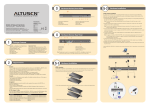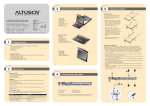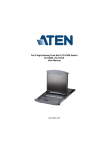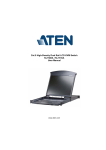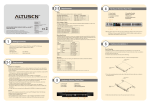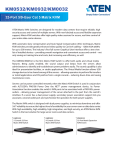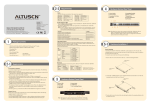Download ATEN KH1516A Specifications
Transcript
3 5-2 Hardware Review (Front View) 1&2 Hardware Installation Single Station Installation (KH1516A) 3 KH1508A/KH1516A Cat 5 High-Density KVM Switch Quick Start Guide © Copyright 2013 ATEN International Co., Ltd. www.aten.com Altusen and the Altusen logo are trademarks of ATEN International Co., Ltd. All rights reserved. All other trademarks are the property of their respective owners. ® This product is RoHS compliant PAPE-1214-Q30G Printing Date: 03/2013 Online Registration • http://eservice.aten.com All information, documentation, firmware, software utilities, and specifications contained in this package are subject to change without prior notification by the manufacturer. Please visit our website http://www.aten.com/download/?cid=dds for the most up-to-date versions. 1 4 5 6 7 5. Firmware Upgrade Port 6. Power LED 7. Station ID LED Hardware Review (Rear View) 1 After the KH1508A / KH1516A is cabled up, you can turn on the power. After it is powered up, you can turn on the servers. 3 2 Package Contents (KH1516A) 1 KH1508A or KH1516A Cat 5 High-Density KVM Switch 1 Firmware Upgrade Cable 1 Power Cord 1 Mounting Kit 1 Foot Pad Set (4 pcs.) 1 User Instructions Important Notice Considering environmental protection, ATEN does not provide a fully printed user manual for this product. If the information contained in the Quick Start Guide is not enough for you to configure and operate your product, please visit our website www.aten.com, and download the full user manual. 2 1. Port Selection Pushbuttons 2. Port LEDs 3. Reset Switch 4. Firmware Upgrade Recovery Switch Technical Phone Support International: • 886-2-8692-6959 China: • 86-10-5255-0110 Japan: • 81-3-5615-5811 Korea: • 82-2-467-6789 North America: • 1-888-999-ATEN Ext: 4988 United Kingdom: • 44-8-4481-58923 4 4 5 1. Power Socket 2. Power Switch 3. Daisy Chain Ports 4. Grounding Terminal 6 4 5 5. Console Ports 6. KVM Port Section Note: The front and rear panel views are similar for the KH1508A, the difference being that the KH1508A has only one row of LED lights (front) and one row of CPU ports (rear) 5-1 Requirements 3 1 2 Hardware Installation Rack Mounting Console • A VGA, SVGA, or multisync monitor capable of the highest resolution that you will be using on any computer in the installation • A PS/2 or USB mouse • A PS/2 or USB keyboard The KH1508A / KH1516A can be mounted in a 19" (1U) rack. The mounting brackets can screw into either the front or the back of the unit so that it can attach to the front or the back of the rack. To rack mount the unit: 1. Remove the screws at the front or the rear, as shown in the diagram below. 2 Phillips head hex M3 x 6 Computers 3 The following equipment must be installed on the computers that connect to the KH1508A or KH1516A KVM ports: • A VGA, SVGA or multisync port • A Type A USB port and USB host controller (for USB KVM adapter cable connection, see following section) - or • 6-pin Mini-DIN keyboard and mouse ports (for PS/2 KVM adapter cable connection, see following section) KVM Adapter Cables • Cat 5e/6 cable is required to connect the KH1508A / KH1516A to one of the KVM adapter cables. • The following KVM adapter cables are required for use with the KH1508A / KH1516A: Function Connect to devices with PS/2 ports Connect to devices with USB ports Connect to Sun Legacy systems (with 13W3 port) Connect to Sun USB systems Connect to serial based devices 1. Ground the KH1508A / KH1516A by connecting one end of the grounding wire to the grounding terminal, and the other end of the wire to a suitable grounded object. Note: Do not omit this step. Proper grounding helps to prevent damage to the unit from surges or static electricity. 2. Plug the console keyboard, monitor, and mouse into the unit’s console ports. The ports are color coded and marked with icons for easy identification. Note: You can use any combination of keyboard and mouse connections. For example, you can use a PS/2 keyboard with a USB mouse. 3. Use Cat 5e/6 cable to connect any available KVM port to a KVM adapter cable that is appropriate for the computer you are installing. Note: To support a resolution of 1280x1024, the recommended maximum distance between the unit and the KVM adapter cable is 50 meters. 4. Connect the KVM adapter cable to the computer. Plug the connectors on the KVM adapter cable into the appropriate ports of the computer you are installing. 5. Plug the female end of the power cord into the KH1508A / KH1516A's power socket; plug the male end into an AC power source. Phillips head hex M3 x 6 2. Screw the mounting brackets into the sides of the unit at the front or the rear, as shown in the diagram below. Phillips head hex M3 x 8 Module KA7920 / KA7520 / KA7120 / KA9520 / KA9120 KA7970 / KA7570 / KA7170 / KA9570 / KA9170 KA9130 / KA7130 KA9170 / KA7170 KA9140 3. Slide the unit into the front or rear of the rack and secure it to the rack. 6 Operation 7 Hotkey Summary Table Port Selection KH1508A / KH1516A installations provide three methods to obtain instant access to any computer on your installation: Manual, OSD (on-screen display), and Hotkey. [A] [Enter] Manual Manual port selection simply involves pressing the port selection switch that corresponds to the device you wish to access. OSD The On Screen Display (OSD) is a menu driven method to handle computer control and switching operations. All procedures start from the OSD Main Screen. To display the Main Screen, tap the OSD hotkey twice. The default hotkey is [Scroll Lock]. You can change the hotkey to the Ctrl key or the Alt key if you like. The OSD incorporates a two level (administrator / user) password system. Before the OSD Main Screen comes up, a login dialog box appears that asks for a username and password. You must provide a valid username and password in order to continue. If this is the first time that the OSD is being run, or if the password function has not been set, simply press [Enter]. The OSD main screen displays in administrator mode. In this mode, you have administrator privileges, with access to all administrator and user functions, and can set up operations (including password authorization) as you like When you invoke the OSD, a screen similar to the one below appears: To bring the KVM focus to a port, double-click it, or move the highlight bar to it and then press [Enter]. Hotkey Hotkeys allow you to conveniently provide KVM focus to a particular computer from the keyboard instead of having to manually select them by pressing port selection switches, or accessing the OSD. Invoking Hotkey Mode Number Lock and Minus Keys (Default) 1. Hold down the Num Lock key; 2. Press and release the minus key; 3. Release the Num Lock key: [Num Lock] + [-] Control and F12 Keys (Alternate) 1. Hold down the Ctrl key; 2. Press and release the F12 key; 3. Release the Ctrl key: [Ctrl] + [F12] [Num Lock] + [-] or [Ctrl] + [F12] Invokes Auto Scan mode. When Auto Scan mode is in effect, [P] or left-click pauses auto-scanning. When auto-scanning is paused, pressing any key or another left-click resumes auto-scanning. 8 Specification Function Computer Connections Direct Max. Port Selection [B] Toggles the Beeper On or Off. [Esc] or [Spacebar] Exits hotkey mode. [F1] Sets Operating System to Windows [F2] Sets Operating System to Mac [F3] Sets Operating System to Sun Daisy Chain [F5] Performs a keyboard / mouse reset on the target computer. F/W Upgrade [H] Toggles the Hotkey invocation keys. Port Selection [Port ID] [Enter] Switches access to the computer that corresponds to that Port ID. KVM Reset [R] [Enter] Administrator only hotkey. It returns the switch’s settings to their default values. [T] Toggles the OSD Hotkey between [Ctrl] [Ctrl] and [Scroll Lock] [Scroll Lock]. [←] Invokes Skip Mode and skips from the current port to the first accessible port previous to it. [→] Invokes Skip Mode and skips from the current port to the next accessible port. [↑] Invokes Skip Mode and skips from the current port to the last accessible port of the previous Station. [↓] Invokes Skip Mode and skips from the current port to the first accessible port of the next Station. Keyboard Console KH1516A 8 16 256 512 (via Daisy Chain) (via Daisy Chain) OSD (On Screen Display); Hotkeys; Pushbuttons 1 x 6-pin Mini-DIN Female (Purple) 1 x USB Type A Female (White) Video Mouse Connectors KH1508A KVM Ports 1 x HDB-15 Female (Blue) 1 x 6-pin Mini-DIN Female(Green) 1 x USB Type A Female (White) 8 x RJ-45 Female In Out 1 x DB-25 Female (Black) 1 x DB-25 Male (Black) 1 x RJ-11 Female (Black) Power Switches 1 x 3-Prong AC socket 8 x Pushbutton 1 x Slide Power LEDs Emulation 1 x Rocker On Line 8 (Green) Selected 8 (Orange) Power 16 (Orange) Station ID 1 x 2 Digit 7-segment (Orange) Keyboard PS/2; USB Mouse PS/2; USB 1–255 sec. 1600 x 1200 @ 60Hz (40 m with KA7xx Adapter Cable) 1280 x 1024 @ 75Hz (50 m with KA7xx Adapter Cable) Video I/P Rating 100-240 VAC; 50/60 Hz; 1A Power Consumption 120V/5.8W; 230V/6W Operating Temp. Physical Properties 16 (Green) 1 (Blue) Scan Interval Environment 16 x Pushbutton 1 x Recessed pushbutton F/W Upgrade Port 16 x RJ-45 Female 120V/5.9W; 230V/6.1W 0–40o C Storage Temp. -20–60o C Humidity 0–80% RH, Non-condensing Housing Metal Weight Dimensions(L x W x H) 2.74 kg 2.77 kg 43.30 x 16.00 x 4.40 cm


